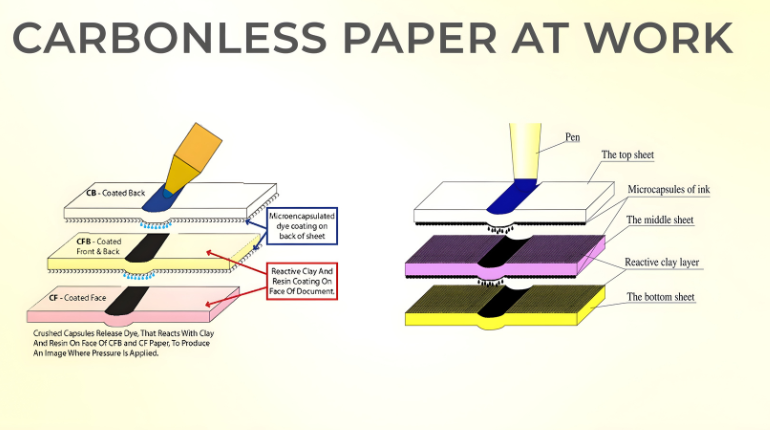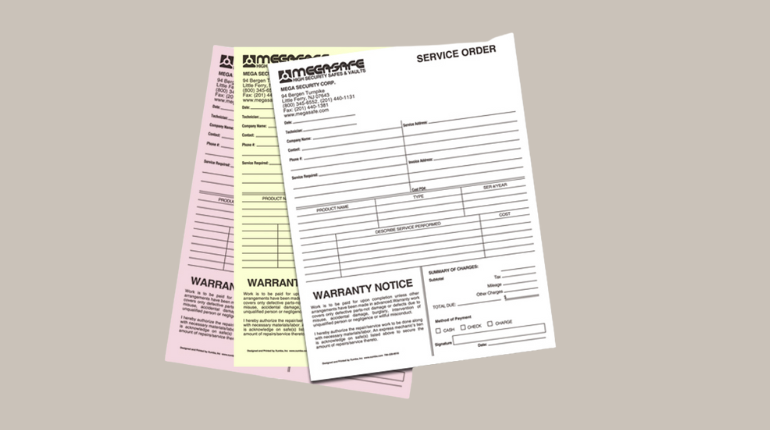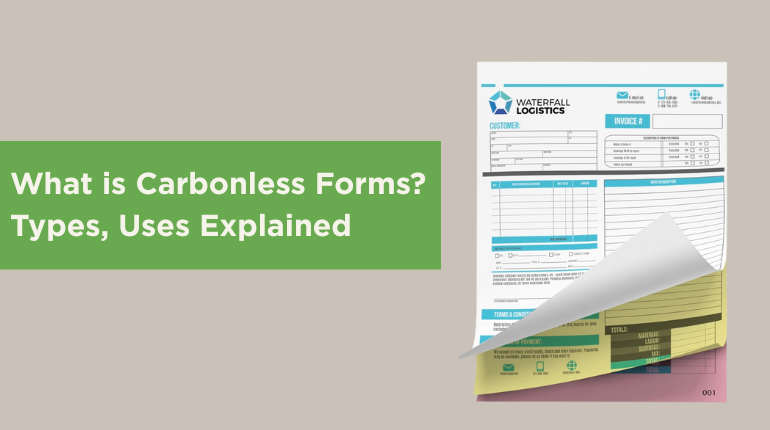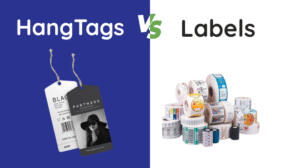What iscarbonless paper? Many marketers and business owners have seen it, but few know how it works or how it can improve business operations. Traditional carbon paper, used for centuries to make exact copies, relied on messy blue underlayments that created dust and sometimes caused respiratory issues.
NCR paper, also called carbonless forms or carbonless copy paper, solves these problems with a clean, modern alternative. These forms use pressure-sensitive microcapsules and layered sheets to create instant copies without carbon. Businesses in retail, logistics, healthcare, education, and finance use NCR forms for invoices, receipts, delivery notes, contracts, and order forms.
In this blog, you will discover what NCR paper is, how carbonless forms work, the different types available, and practical tips to choose the right one for your business needs.
Key Takeaways
- NCR (No Carbon Required) paper is a type of carbonless form that allows businesses to create instant, accurate, multi-copy documents without using traditional carbon sheets.
- The chemical layering system in NCR forms ensures precise duplication across two-part, three-part, or multi-part forms, saving time and reducing errors.
- Carbonless forms are versatile, cost-efficient, clean, and professional, allowing businesses to streamline operations while maintaining accurate and verifiable records.
What are Carbonless Business Forms?
Carbonless forms, also called No Carbon Required (NCR) forms, let businesses create instant copies of handwritten, typed, or impact-printed documents without using carbon paper.
These forms consist of multiple paper layers coated with micro-encapsulated dye and reactive clay. When someone writes or prints on the top sheet, the dye capsules burst and react with the clay on the sheet below, producing an exact duplicate of the original content.
NCR forms replaced traditional carbon paper, which was messy, fragile, and released potentially harmful blue dust. Modern carbonless forms use safe, non-toxic coatings, making them ideal for invoices, receipts, delivery notes, order forms, contracts, and other business documents.
Manufacturers provide two-part, three-part, and multi-part NCR pads to suit different operational needs across retail, logistics, healthcare, and educational sectors.
The History of NCR Paper
- 1800s:Carbon paper invented for making duplicates; thin sheets with dark carbon coating transferred writing or typing to underlying sheets; messy, stained, and insecure for confidential documents.
- Early 1950s:NCR paper invented by National Cash Register Company; multi-layered sheets with micro-encapsulated dye and reactive clay created instant copies without carbon; named NCR, later called “No Carbon Required.”
- 1950s–1970s:Retail, logistics, healthcare, and educational sectors adopted NCR forms; multi-part pads and books enabled record-keeping and distribution.
- 1980s–2000s:Typewriters replaced by word processors and desktop printers; NCR forms remained essential for invoices, receipts, contracts, and order forms.
- Present Day:NCR forms continue to provide secure, clean, and efficient duplication; businesses, hospitals, schools, and logistics companies rely on two-part, three-part, and multi-part carbonless forms.
How Does Carbonless Paper Work?
Carbonless forms, or NCR paper, use a precise chemical system to create instant copies without carbon sheets. The top sheet, called the CB sheet, carries microscopic dye capsules on its back. When you write on it, these capsules break open and release dye.
The second sheet, called the CF sheet, has a reactive clay coating on top. The dye from the CB sheet reacts with the clay, forming a clear and permanent copy. This system allows businesses to produce exact duplicates of documents like invoices, receipts, or delivery notes efficiently.
For multi-part forms, or CFB sheets, the process repeats across several layers. Each intermediate sheet has a dye capsule layer on the bottom and a reactive clay layer on top. The final sheet only has the reactive clay layer, ensuring the writing transfers through all sheets accurately without smudging.
This chemical layering enables precise, clean, and immediate duplication, eliminating the need for messy carbon paper and making NCR forms ideal for businesses in retail, logistics, healthcare, and administration.

What are the Common Types of Carbonless Forms?
Carbonless forms let businesses produce multiple copies of a document at once, ensuring consistency and accurate record-keeping. Various industries use them for essential paperwork:
- Two-Part NCR Forms (CB + CF): Create a single copy for the customer and one for internal records.
- Three-Part NCR Forms (CB + CFB + CF):Produce multiple copies for multiple stakeholders.
- Four-Part NCR Forms:Ideal for detailed documentation needing several identical copies.
- Invoices and Receipts:Provide clients with instant proof of transactions while keeping clear internal copies for accounting.
- Service Orders:Record detailed job instructions, authorizations, and progress in maintenance, repair, or service businesses.
- Sales Orders:Track product or service requests to ensure accurate fulfillment and monitor inventory.
- Contracts and Agreements:Enable multiple parties to retain identical, legally binding documents.
- Purchase Orders:Document procurement requests, supplier communications, and order confirmations.
- Shipping and Receiving Forms:Record shipment details, delivery confirmations, and goods receipt for logistics and inventory management.
- Delivery Notes:Offer proof of delivery while maintaining internal tracking for billing and reporting.
Benefits of NCR Paper
NCR paper offers businesses a modern, efficient way to create multiple copies instantly. Its advantages span across operations, accuracy, and cost-efficiency.
- Error Reduction:The chemical transfer system ensures precise duplication, minimizing mistakes in invoices, receipts, and contracts.
- Time Efficiency:Multiple copies are produced simultaneously, saving employees hours compared to manual copying or carbon paper.
- Clean and Safe:NCR forms eliminate messy carbon sheets and dust, protecting workplaces and reducing health risks.
- Cost Savings:Businesses save on carbon paper, printing, and rework costs while improving operational efficiency.
- Versatility:NCR forms work for retail, healthcare, logistics, education, and service industries for receipts, work orders, delivery notes, and contracts.
- Professional Appearance:Copies remain clear, legible, and durable, maintaining professional documentation standards.
- Eco-Friendly Options:Many manufacturers provide recycled or sustainably sourced NCR forms, reducing environmental impact.
Uses of Carbonless Forms
Carbonless forms streamline documentation in a wide range of industries. Businesses use them to record transactions, track orders, and maintain accurate records efficiently.
- Retail Operations:Track purchases, generate receipts, and manage product orders.
- Service Providers:Document invoices, service requests, and signed agreements.
- Healthcare Facilities:Record patient visits, insurance submissions, and treatment logs.
- Manufacturing Units:Manage purchase requests, production orders, and shipment paperwork.
- Transportation & Logistics:Log delivery confirmations, bills of shipment, and inventory transfers.
- Construction Projects:Record contracts, change orders, and project approvals.
- Hospitality & Restaurants:Track guest orders, issue bills, and maintain order history.
- Specialty Shops:Manage sales, register logs, and customer orders.

Are you in the market for Custom-Printed Business Forms?
Whether you need forms for deliveries, sales, inventory, or contracts, carbonless paper makes record-keeping simple. Now that you understand what carbonless paper is and how it works, you can create and print your forms through Print to Brand.
Choose the multi-part form that fits your business needs, add sequential numbering for easy tracking, and use protective options like shrink wrapping to keep your forms organized and ready to use.




